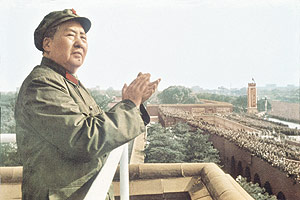With the emperor Pu Yi politically powerless and to avoid a fratricidal struggle which would destroy the success of the revolution, Sun Yat-Sen gave up the presidency of the new born republic to General Yuan Shikai (Yuan-Che-Kai). Nevertheless, Shikai did not put the democratic constitution of 1913 into effect and he became a dictator, dying three years later.
The discontent of the proletarian masses in the cities was the base which sustained the Chinese Communist Party, founded in 1921. This political conglomerate was influenced by the Russian Revolution and the protests of the 4th of May, 1919 against the cession of the former German possessions in China to Japan after the signing of the treaty of Versailles.
In 1923 Sun Yat-sen accepted the incorporation of the communists into his party when they were brutally repressed by the «warlords» (military leaders) and were looking for allies. Furthermore, Sun knew that in this way he would obtain the support of the Soviet Union.
The Final Triumph
Following the death of Sun Yat-sen in 1925, Chiang Kai-Shek (Jiang Jieshi) became leader of the Guomindang. He brought an end to the «warlords» and reunified China, imposing a Nationalist government with himself as President and Nanking as capital. In order to do this he massacred the massed workers in Shanghai and Guangzhou which provoked the flight of the Communists, headed by Mao Tse-Tung (Mao Zedong) and Zhu De, to the mountains in the south of Jiangxi, where they continued searching for supporters of their cause, now among the peasantry.
Mao Zedong and his forces combated the reactionary and imperialist policies of Chiang Kai-Shek, which were supported by the United States and Great Britain.
Although the communist leader had to escape Jiangxi in 1934, his flight to Shanxi, called «The Long March» because of the 10,000 km which had to be walked, allowed him to establish a new revolutionary base and move on to counterattack.
Meanwhile, Japan founded an independent state of China with the name of Manchuria in 1932 and placed Pu Yi in power. This set off a series of confrontations between China and Japan which led to armed conflict in 1937. The communists and nationalists made a truce and struggled against the Japanese, who, after their capitulation at the end of the Second World War (1939-1945), abandoned all conflict with the Chinese.
Nevertheless, the civil war was resumed until 1949, when the Red Army of Mao Zedong controlled practically the whole country and the People’s Republic of China was established.
The Great Leap
During the new regime, presided over by Mao Zedong and with Zhou Enlai as Prime Minister, agricultural reform took place and financial and commercial institutions were nationalized. In 1953, imitating the soviet model, a five year plan was begun, to accelerate the process of industrialization and production through agricultural and industrial cooperatives.
After the success of this plan, there was an attempt to speed up the introduction of communist society named «The Great Leap Forward«. Nevertheless the project failed and Mao had to leave power (1959). Despite this he did not lose his influence in the country or in the party, in the latter as its President, a position he held until his death.
In the international arena Tibet, under Chinese rule, rebelled, and diplomatic relations with the Soviet Union were broken (1960) due to territorial and ideological disputes. Afterwards China began a period of isolationism, only supporting those countries which followed its doctrinaire tendencies.
The Cultural Revolution
In 1966, Mao and his right hand Lin Biao led a movement called the «Cultural Revolution«. This had the objective of purging and distancing the moderates, led by Deng Xiaoping, from the government and consolidating the ideological purity of Chinese Communism. Books and works of art were burnt, all of the symbols of the old China were crushed and the country fell into a state of economic and social chaos.
However, after the Cultural Revolution, agriculture, industry, science and the army were modernized. Furthermore, China began to reinsert itself into the international community and reestablished relations with some capitalist countries, such as the United States.
After Mao’s death in 1976, China entered a period of greater liberalization. A new constitution was drafted in 1982 and the creation of small private enterprises in certain economic zones was allowed. Nevertheless, China has maintained its socialist ideology, as shown by the severe repression of pro-democracy student demonstrations at Tianamen Square in 1989.








 Muere Evita
Muere Evita